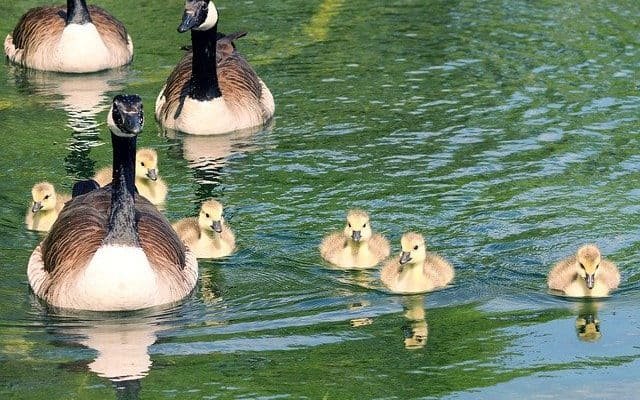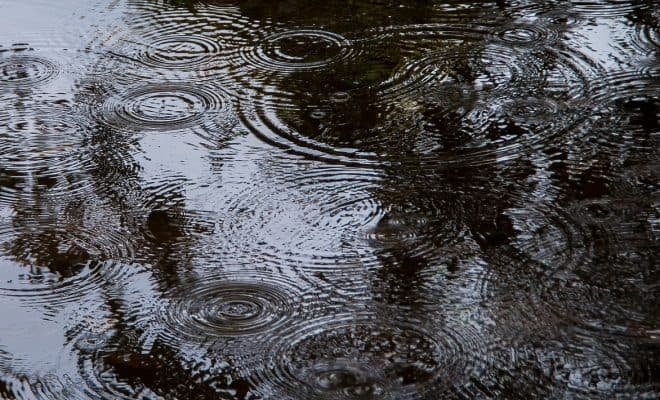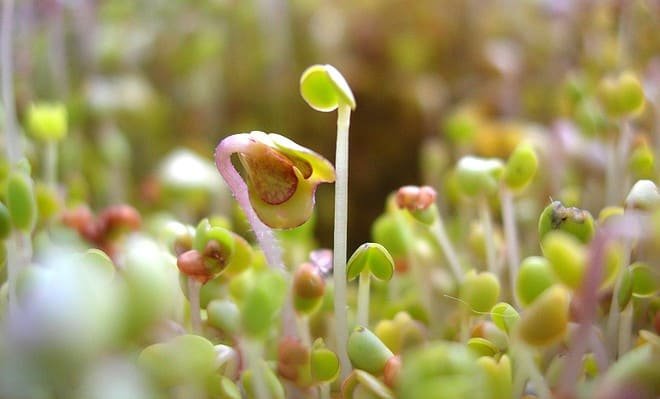Peace For Our Geese

When my husband and I decided to move to Savannah, Georgia, we selected a beautiful house. It met all our needs with space as well as aesthetics. The nicest part about the property is it has a drainage pond off the back yard. In this pond, there were a few mallard ducks and several geese floating around. Each morning, the geese would fly in, making a ruckus. We would sit outside in the morning, drinking our coffee, and when we heard them, we’d say, “Good morning, girls.”
At twilight, another mass exodus of them flying off to wherever they’d spend the night. Again, we’d say, “Good night, girls, see you tomorrow.” During the day, they’d swim around or walk along the banks eating small sprouts of green grass or preen themselves. We could tell who the pairs were because they stayed close together, as newlyweds.
In June, we noticed a pair of geese had hatched goslings. Witnessing how nature protects their young was astonishing. The mom would swim in front, the three goslings right behind her, and dad took up the rear. Each adult is overly protective of their little family. No other geese were allowed to go near them. We watched in fascination as the parents taught the goslings how to find food, swim, and avoid hidden dangers. We took videos and photos of them. We laughed at their antics. Each night, the five of them would swim over to the east end of the pond, hop out and disappear among the tall reeds.
The first day the geese didn’t show up, we didn’t think too much about it. Since there are over 50 ponds throughout the subdivisions, we assumed they spent the day somewhere else. On the second day, when the geese didn’t show up, we thought it was odd since we had lived there a year, and they were always in our pond. Neither the mating pair nor the goslings showed up. The mornings were eerily quiet.
I decided to check out the other ponds to see where the goslings may be. I hopped on my bike and started riding the neighborhood; Not one goose on the site and no goslings in any of the ponds. The ducks were gone as well. Weird, I thought. I went home and put out a post on Nextdoor, a neighborhood social media site, “Where are our geese?” The responses brought me to tears.
One guy said they had all been rounded up and relocated. Another woman responded she had seen the USDA out at one of the other subdivisions rounding up geese and putting them in turkey crates. I was heartbroken. Why on earth would someone remove all the geese? Another woman said they did it every two to three years to reduce the population.
Our little family of geese was gone, and we had no idea what happened to them. I decided to dig a little further. It was then when I found out a horrible truth. Somebody did not relocate our geese. Somebody had euthanized them with carbon monoxide. It is a common practice throughout the United States. I was under the assumption that Canada geese were protected under the Federal government. They are unless you get a permit to kill them as nuances. One complaint is all it takes, and the USDA will provide you with a license to have the geese removed and destroyed by either euthanasia or breaking their necks (culled.)
It’s big business for them too. It allows the USDA to earn millions of dollars. Big cities pay big money to remove geese from parks and ponds; New York, New Jersey, Pennsylvania, Maine, Massachusetts, Illinois, Colorado, Georgia, California, Michigan, Minnesota, and these are just the states I found my research. Fifty percent of their funding comes from culling geese. I find this ironic because the history of the Canadian geese reads like a torture story.
In the first half of the 20th century, hunters captured migratory geese for use as live decoys. These hunters would put weights on their legs to hold them down in the water after clipping their flight feathers. The geese would squawk, bringing other geese into the shooting site. The captive geese bred in captivity, so they did not have the biological need to migrate to Canada since geese nest in the area where they were born. By the 1960s, the increase in hunting resulted in the near extinction, and resident flocks were mostly gone. The USDA began a re-population of wild Canada geese.
The USDA teams would take eggs from nests and artificially incubate the eggs. This caused the mating pair to lay another clutch. There are now two species of Canada geese, resident geese and migrating geese. This was when migratory birds became protected by the Federal government.
Resident geese nest in the early spring and have their goslings in May. They must stay in the area to protect and raise their goslings. The goslings cannot fly until mid to late August, well after their parent geese molt, which begins in June. When parent geese molt, they lose the ability to fly. Therefore, the parent geese and the goslings are biologically “trapped” in the area they had nested and then subsequently molted. And this is when the mass executions begin.
Geese are predictable creatures. They are monogamous and will mourn the loss of their mate for years. Mating pairs all nest at the same time and are in pairs, not flocks. Juvenile geese under three years of age do not nest. In early May, the geese look for a safe place to molt. Most geese will go on a molt migration. Only injured geese or geese with goslings remain at their nesting site.
Most geese are flightless by mid-June, and this is when the roundups occur. Geese like to pond jump, so if there are multiple ponds in an area, they may sleep in one pond and then fly to several different ponds during the day. In September, the numbers of geese may increase in city ponds with the start of early hunting season as geese may fly out of the rural areas for sanctuary in the suburbs and cities. They are not only instinctual but smart.
Here is what I have done, along with several other women, in nearby subdivisions to change this stabilization method:
I met with like-minded residents to hear if they had a plan. One woman, Anna, told me about several organizations she had contacted and then forwarded me their contact information.
I sent them each an email letting them know I was interested in starting up a similar program to theirs and if they could send me some information.
GeesePeace is a non-profit organization with a proven method that works, and they are willing to train us so we can implement it in our neighborhoods.
I sent an email to my HOA board asking questions about our USDA contract and asking them if they would be willing to look at a plan to stabilize the geese population humanely. We set up a Zoom meeting. The look on their faces when I told them the USDA had euthanized the geese was priceless. I knew they lied to about the geese had been relocated. The USDA’s normal response to make people’ feel good’ about using their service.
I produced a PowerPoint highlighting all my information and sent it to the HOA board.
I posted another post on Nextdoor Neighbor, where Anna had set up a private room called Canada Geese Preservation. She informed everyone of my PowerPoint and my willingness to share it with them so they could share it with their HOA board members in their subdivisions.
I attended a Zoom meeting with people from Urbana, IL, Crystal Lakes area, where the same thing happened to their geese back in June 2020. Their presentation was broadcast via their local community radio station. I joined their Facebook page so we could share information. They, too, want to implement GeesePeace’s stabilization plan.
I started a petition at Change.org and sent it out to everyone I knew and will be doing this every day until we have thousands of signatures.
Anna is setting up an LLC and business plan for our organization.
I have called out to all the subdivisions for volunteers willing to help stabilize the geese population.
This is still an ongoing effort, but our plan needs to be in place by January 2021 to stop the contract from being used in June of 2021 by the USDA.
How do you stabilize geese humanely, you ask? It starts with volunteers locating nesting sites. It is unlawful to remove nesting sites, but we can log where they are and visit them. If we find an area with eggs, the eggs are tested. Testing eggs is easy and simple. You drop the eggs in a gallon of water; if they sink, you need to put them back; if they float, you must oil them with 100% corn oil. They won’t hatch if you do this. You can also replace the eggs with wooden eggs, which look exactly like the real eggs, and the mother goose doesn’t know the difference.
Border collies are another way to discourage geese from staying too long on a pond. By bringing the Border collie to the geese in a kayak or boat, the water sanctuary is no longer available to the geese, so they move on.
This operation runs from the second week in May and continues until mid-June or early July.
Red or green lasers used at twilight (or dawn) get them to move on.
Add landscaping along with the ponds. Tall reeds or grass along the edge of a pond make geese nervous as their predators can hideout.
A “no feeding” program must be implemented. If humans feed geese, they may approach people. It can cause a deformity in goslings called angel wing, which will prevent them from ever being able to fly. Geese will congregate in areas where they know they will be fed, and feeding bread, corn, or other treats may keep them from going on a molt migration.
The results have proven it works. The first year, a significant reduction by Memorial Day was seen, with most geese gone by mid-June.
After three years, there was a dramatic reduction in geese numbers during the nesting period. And each year, there may be geese in the area if the nests are missed, but the presence of these geese will be a positive addition to the natural areas.
With the egg oiling program’s implementation, the population will stabilize. More resident geese will go on a molt migration as they won’t have goslings keeping them in the program area.
I can only hope we can make a difference with this program. The death of those three little goslings will not be in vain. I only wish I had known about it before the USDA killed the geese. Here is a link to our petition; please sign it if you would like to see a change in the methods used to stabilize resident geese.









